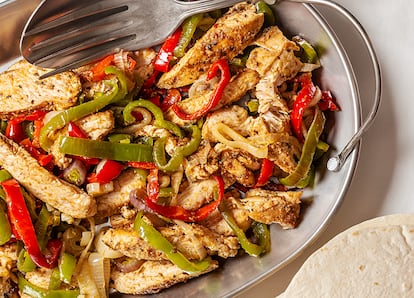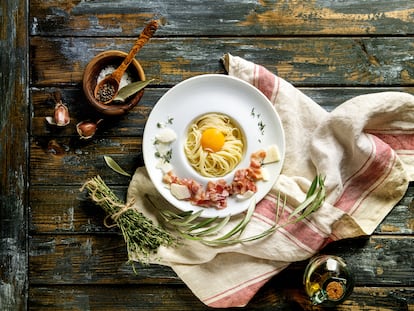Fajitas, a Mexican dish that was really born in Texas
The famous strips of grilled meat with sautéed vegetables inside a tortilla wrap were first made by ranch hands who were paid with leftover cuts

Contrary to what many people think, fajitas did not emerge in Mexico but in the United States. Specifically in Texas, where they became popular in the 1970s and reached stardom in the 1980s, although their origins can be traced back to 40 years earlier, when Mexican workers on ranches cooked the leftover cuts of meat that they received as pay over the fire or on the grill.
Fajitas usually consist of strips of meat cooked on the grill, mixed with sautéed vegetables — usually bell peppers — and wrapped in tortillas, to be eaten as a roll. It is common to marinate the meat in a mixture of spices and sometimes also some liquid that can be alcoholic or not. Marinating the meat helps to give more flavor and to soften it up if it is tough. Since the fajitas we propose to make today use chicken, they do not require a long marinating process.
They say that the basic spice mix for fajitas should include dried chili peppers, cumin, coriander grains, white pepper, oregano, smoked paprika and garlic powder. This is not difficult to put together, plus the chili peppers can be replaced with Cayenne peppers. Don’t hesitate to prepare two or three times more seasoning than you actually need: it will serve to spice up other grilled meats, poultry and all types of stews.
The secret to good fajitas lies in a tasty and spicy seasoning, and in not overheating the chicken too much, so that it remains juicy. A fresh side dish such as guacamole or pico de gallo will do the rest, and the sour cream — although this brings it closer to a Mexican recipe than a Tex-Mex one — provides a very interesting point of freshness, creaminess and acidity.
Recipe: Chicken fajitas
Preparation time: 25 minutes
Difficulty: Low, but it's important not to dry out the chicken too much
Ingredients for two servings
For the seasoning:
1/2 teaspoon ground chili pepper
1/2 tsp ground cumin
1/2 tsp sweet paprika powder
1 tsp garlic powder
1/2 tsp dry oregano
1/2 tsp salt
1/2 tsp white pepper
For the fajitas:
2 chicken breasts
3/4 red onion
1 red pepper
1 green bell pepper
Virgin olive oil
1/2 lime
4 to 8 flour tortillas, depending on size
Guacamole, pico de gallo or sour cream to taste
Steps
1. Combine all the seasoning ingredients in a bowl.
2. Peel the onion and cut in julienne strips. Remove the seeds and tops from the chiles, then slice.
3. Remove skin from the chicken breasts, butterfly them (slice in half horizontally to make them thinner) and season them.
4. Brush the bottom of a frying pan with olive oil. Put the pan on high heat and sear the chicken for a few instants on both sides.
5. Place the chicken on a plate for later. Add more oil to the pan and stir fry the onion and peppers.
6. Cut the chicken into strips and cook at high heat, adding any remaining seasoning.
7. Squeeze the lime to sprinkle juice over the chicken and pepper mix. Serve immediately with tortillas, guacamole, pico de gallo and/or sour cream.
Sign up for our weekly newsletter to get more English-language news coverage from EL PAÍS USA Edition
Tu suscripción se está usando en otro dispositivo
¿Quieres añadir otro usuario a tu suscripción?
Si continúas leyendo en este dispositivo, no se podrá leer en el otro.
FlechaTu suscripción se está usando en otro dispositivo y solo puedes acceder a EL PAÍS desde un dispositivo a la vez.
Si quieres compartir tu cuenta, cambia tu suscripción a la modalidad Premium, así podrás añadir otro usuario. Cada uno accederá con su propia cuenta de email, lo que os permitirá personalizar vuestra experiencia en EL PAÍS.
¿Tienes una suscripción de empresa? Accede aquí para contratar más cuentas.
En el caso de no saber quién está usando tu cuenta, te recomendamos cambiar tu contraseña aquí.
Si decides continuar compartiendo tu cuenta, este mensaje se mostrará en tu dispositivo y en el de la otra persona que está usando tu cuenta de forma indefinida, afectando a tu experiencia de lectura. Puedes consultar aquí los términos y condiciones de la suscripción digital.
More information
Archived In
Últimas noticias
Alain Aspect, Nobel laureate in physics: ‘Einstein was so smart that he would have had to recognize quantum entanglement’
Imelda Castro, the woman who wants to rule the cartel battleground of Sinaloa
The new victims of the Republican war on Obamacare: Millions hit by soaring health insurance premiums
A country divided on migrant rights: Some US states expand protections while others restrict them
Most viewed
- David King, chemist: ‘There are scientists studying how to cool the planet; nobody should stop these experiments from happening’
- Reinhard Genzel, Nobel laureate in physics: ‘One-minute videos will never give you the truth’
- Oona Chaplin: ‘I told James Cameron that I was living in a treehouse and starting a permaculture project with a friend’
- Sinaloa Cartel war is taking its toll on Los Chapitos
- Mexico completes its trade shift with the entry into force of tariffs on China and countries without trade agreements











































